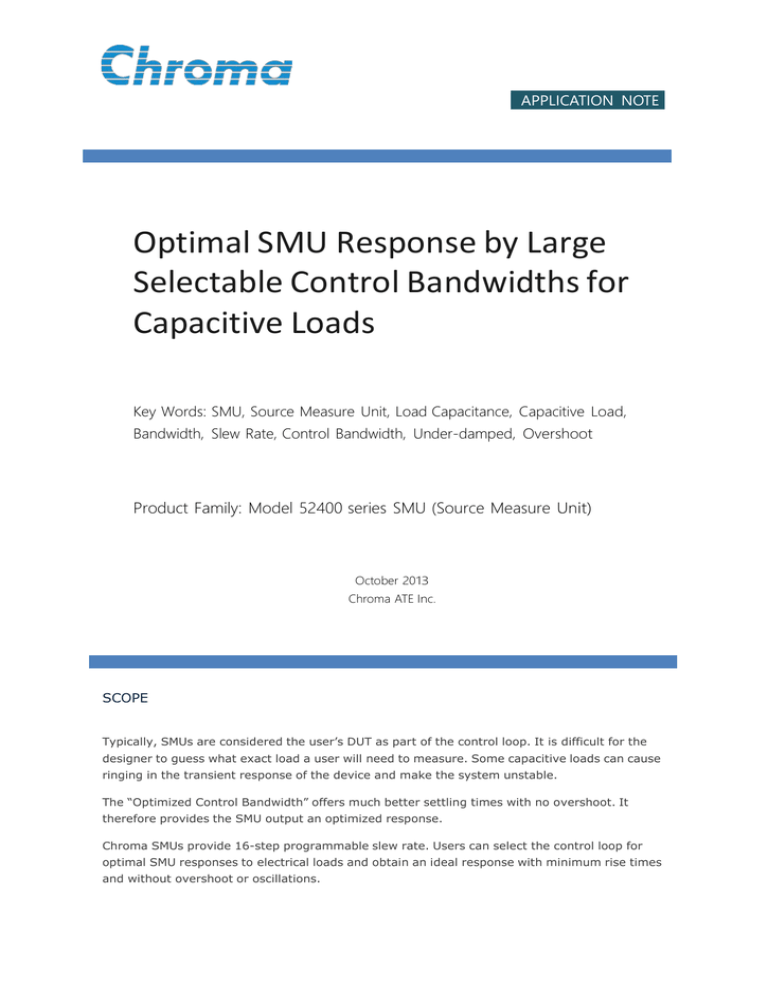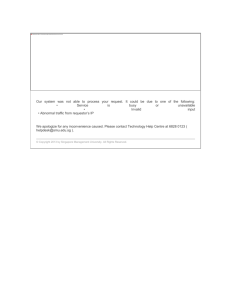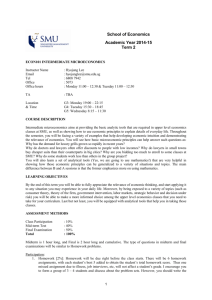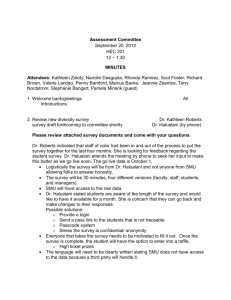
APPLICATION NOTE
Optimal SMU Response by Large
Selectable Control Bandwidths for
Capacitive Loads
Key Words: SMU, Source Measure Unit, Load Capacitance, Capacitive Load,
Bandwidth, Slew Rate, Control Bandwidth, Under-damped, Overshoot
Product Family: Model 52400 series SMU (Source Measure Unit)
October 2013
Chroma ATE Inc.
SCOPE
Typically, SMUs are considered the user’s DUT as part of the control loop. It is difficult for the
designer to guess what exact load a user will need to measure. Some capacitive loads can cause
ringing in the transient response of the device and make the system unstable.
The “Optimized Control Bandwidth” offers much better settling times with no overshoot. It
therefore provides the SMU output an optimized response.
Chroma SMUs provide 16-step programmable slew rate. Users can select the control loop for
optimal SMU responses to electrical loads and obtain an ideal response with minimum rise times
and without overshoot or oscillations.
Optimal SMU Response by Large Selectable Control Bandwidth for Capacitive Loads
SMUs (Source Measure Units) are remarkable
instruments to test and measure the
current-voltage (I-V) characteristics for a variety
of semiconducting devices. These conductive
devices include LEDs, Laser Diodes, Solar Cells,
Batteries, FETs, MOSFETs, and more.
Generally, SMUs remain stable when sourcing/
driving a capacitive load. Sometimes though,
certain capacitive loads can cause ringing in the
transient response of the device and make the
system unstable.
I is the current limit
C is the total capacitance across the load
In electronics, slew rate is defined as the
maximum rate of change of output voltage per
unit of time and is expressed as volts over
microseconds.
RESPONSE TIME
The response time or response speed of the SMU
directly affects the performance in measurement
accuracy and the measurement throughput.
When the DUT is loaded onto the output of an SMU,
attention must be paid as there is a specific limit
on the capacitance. Attaching large capacitive
loads to the SMU output can result in oscillation,
so users need to make sure that the input
capacitance does not exceed the specific limit of
SMU load capacitance.
WHAT IS A CAPACITIVE LOAD?
A capacitive Load refers to capacitance external to
Figure-1 Transient Response
the SMU, contained within the feedback loop of
the oscillator circuit.
A capacitive Load may cause peaking and
oscillation. A capacitive load connected to the
output of a SMU that causes undesired results and
slows down the system.
BANDWIDTH & SLEW RATE
Bandwidth determines the instrument’s ability to
respond to time varying signals over a range of
frequencies. The measure of the instrument’s
response is the ability to respond to a step
Figure-1 shows transient response of the case at
5A current load that shows a slightly large spike
compared with the 3A current load that the settle
time to the final voltage is quick and stable,
without any ringing.
Good transient response is with a small overshoot
in the rising and falling edges. The settling to the
final voltage is quick and stable without any
ringing. A part of the rise time depends on the
SMU slew rate and the CR time constant added in
series to the analog control input of the SMU.
function; the typical measure of response is the
rise time of the instrument.
The slew rate is the maximum rate of change of
the output voltage as a function of time. The slew
rate is limited to the output current limit divided
by the total load capacitance, as expressed in the
SMU STEP RESPONSE
Figure-2 shows the behavior of the control loop
with a capacitor as a capacitive load. The response
is under-damped, and it overshoots and takes a
long time to settle. If the primary concern is to
following equation:
eliminate the overshoot, user can achieve a fast
(△V/△t) = (I/C)
rise time while avoiding overshoots and
Where △V is the change in the output voltage
bandwidth.
△t is the change in time
Chroma ATE Inc.
oscillations by selecting a suitable control
www.chromaus.com
Optimal SMU Response by Large Selectable Control Bandwidth for Capacitive Loads
bandwidth to be stable on a wider range of loads,
but the response would look like the brown curve
(Undershoot) in Figure-3.
The output amplitude “Optimized Control
Bandwidth” is achieved dramatically much better
settling times with no overshoot. It lets us
understand “Optimized Control Bandwidth” lets
the SMU output an optimized response.
Figure-2 1.5V Step Response with 0.1 uF Capacitor as
capacitive Load
CONTROLLABLE BANDWIDTH
To increase test speeds, shorter settling time and
faster rise/fall time (or slew rate) are required.
This can be achieved by increasing the control
bandwidth.
However, with different cable impedance or DUT
characterization, high control bandwidth will
sometimes cause oscillation. Therefore, to
Figure-3 1.5V Step Response with 0.1 uF Capacitor as
capacitive Load
optimize test speed and stability, adjustable
bandwidths are required. Figure-3 shows the
condition of a voltage waveform under different
control bandwidths.
OPTIMIZED CONTROL BANDWIDTH
SMUs have the unique characteristics that the
user’s DUT is part of the control loop. It is
impossible for the designer to guest what exact
Figure-4 shows 5 different Bandwidth settings of
the 16 available Bandwidth Control of Chroma’s
SMU. Adjusting the bandwidth of the analog force
loop, allows the customer to finely adjust the loop
Bandwidth to optimize speed with different
capacitance loads. The additional Bandwidth
setting becomes important and mandatory for
customers who want to go fast.
load the user needs to measure. Even if known,
there is no practical way to match the
analog-controlled instrument and the load with
programming.
Figure-3 shows three possible responses when
driving 1.5 Volt into a 0.1 uF capacitor. The purple
response (Saturation or Oscillation) is similar to a
high-bandwidth SMU designed with high-sourcing
speed. Note the overshoot, which is likely to stress
or damage the DUT. Even though the objective
was a fast response, the response is so underdamped that it takes a long time to settle to the
desired value.
SMUs could also be designed with a lower
Chroma ATE Inc.
Figure-4 SMU Output Waveform under Different Control
conditions
www.chromaus.com
Optimal SMU Response by Large Selectable Control Bandwidth for Capacitive Loads
Chroma 52400 Series SMUs
settling time in microseconds with accuracy of
With 16 Control Bandwidths to select from, users
nano-Volts and nano-Amps, 16 Control Bandwidth
Selection to avoid oscillation and for shorter settling
can control the SMU’s responses to electrical loads,
achieving an ideal response with minimum rise
times and without overshoot or oscillations.
Control Bandwidths help custom tune Chroma’s
SMU response to a given load. This provides an
optimal SMU response with minimal times (faster
time, hardware sequencer for precise output
profile control, fast respond clamp circuit to
protect DUT, and unique programmable resistance
to simulate battery. These features make Chroma
52400 SMUs ideal measurement tools for
semiconductor testing.
measurement speed), it eliminates overshoots to
In addition, the 52400 series SMU complements
protect the DUT, and oscillation to ensure system
excellent accuracy and repeatability with fast
measurement speed. It can operate as a four
quadrant voltage/current source, an electrical
stability.
load, a voltage/current meter, a pulse generator
and an arbitrary waveform generator.
Figure-5 Chroma’s 52405 SMU PXI Card Hardware
Model 52400 series SMU
Structures
Chroma’s SMU provides 16-step programmable
For more detailed information about Chroma 52400
series SMU & other Chroma solutions, please visit
Chroma’s website at: www.chromaus.com
slew rate of up to 9V/usec. With this fast slew rate,
the test throughput is much higher than
conventional SMUs. Figure-5 shows the diagram
of Chroma 52405 SMU PXI Card Hardware
Structure.
Chroma 52400 series SMU features high
precision,
www.pxisa.org
Specifications and descriptions in this document are subject
to change without notice.
©Chroma ATE Inc. 2013
Chroma ATE Inc.
All Rights Reserved
www.chromaus.com




